Boom, Roasted
Not every fast food chain is going to be a success. And often, the best you can hope for is the kind of revival Kenny Rogers Roasters is having in Asia.
“I know I am in good company with international music sensation Armando Christian ‘Pitbull’ Pérez as an equity partner.”
— Nan Oo, a Myanmar-based franchisee for Miami Grill, discussing the launch of the sub chain in the country. The chain, launched in 1988 as Miami Subs and mostly based in Florida, has faced a somewhat complicated corporate history, with Nathan’s Famous buying out the chain in 1998, not long after a failed merger attempt with Arthur Treacher’s. (The two chains would come together under Nathan’s ownership.) In 2012, a longtime fan of the sub chain, Pitbull, ended up buying a large equity stake in the chain, which is officially how all things happen in Miami. “Pitbull is the guy to take us to the next level,” Miami Grill CEO Richard Chwatt said at the time. “The brand is going to be synonymous with him. We need to translate his energy to our stores. We think he can get that done.” In case you needed any more proof that Pitbull is the modern day Kenny Rogers, here you go.
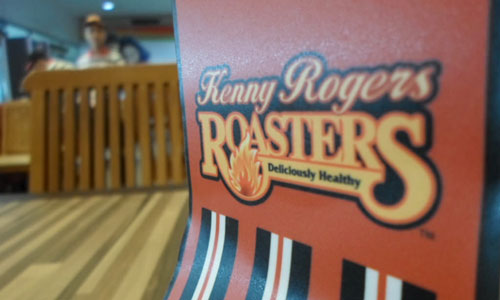
Kenny Rogers Roasters. (Investment Total/Flickr)
Kenny Rogers Roasters is probably bigger now than it was in the ‘90s (really)
In 1991, country crooner Kenny Rogers made an unlikely decision to commercialize his name.
While his “Islands in the Stream” cohort Dolly Parton had found success with a theme park, Kenny Rogers agreed to let his likeness become the face of a rotisserie chicken chain.
The idea came from former Kentucky Gov. John Y. Brown, who had turned KFC into a large international chain. At first, Kenny Rogers Roasters was on the same track; by 1994, the company already had 109 locations.
The chain did not always have a strong level of appreciation, however. In 1996, a New York City lawyer located directly above a Kenny Rogers Roasters location put a sign directly above the store, claiming the food was bad. Aaron Chess Lichtman’s sign was placed effectively because he was annoyed by the bright lights of the restaurant’s signage, but a court sided with the man anyway.
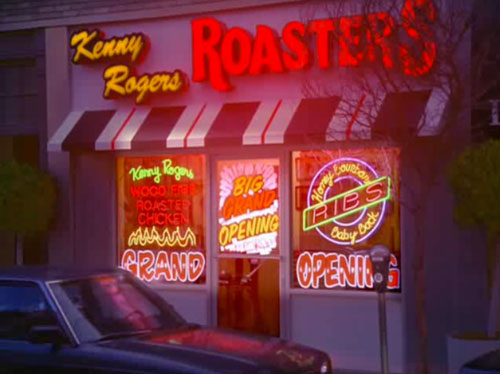
The Kenny Rogers Roasters signage, as shown on Seinfeld. (YouTube screenshot)
Soon afterwards, a Seinfeld episode, somewhat based on the lawsuit but with the added element of Kramer becoming addicted to the product, became a massive boost of publicity for the chain.
A Kenny Rogers Roasters ad in 1995.
The chain eventually faltered, and by 1998, Rogers was trying to disassociate himself. Nathan’s, inevitably, bought it, because they bought every chain around this time.
But the real story about the chain is what it’s doing these days. In 2008, it was purchased by a Malaysian firm, which quickly ramped up its Asian presence. By 2011, Time Magazine reported that the chain was earning $100 million in revenue, despite the fact that many Asian mall shoppers have no idea who Kenny Rogers even is.
A Kenny Rogers Roasters ad in 2011. Beyond the logo, Kenny is nowhere to be seen.
And from there, it’s still going strong. Last year, the chain opened up its first Indian location, with the goal of reaching $10 million in sales and 40 to 50 locations in India alone by 2021. There are more than 400 locations worldwide—topping its ‘90s peak of 350 restaurants.
For years, there was just one location in the U.S.—at California’s Ontario Mills Mall—but that location has now closed.
Considering all that, why did I see the Kenny Rogers Roasters co-branding at the airport? Simply, it’s because of a business arrangement laid out as part of the 2008 sale of Kenny Rogers Roasters. According to a 10-K disclosure form filed by Nathan’s Famous last year, the company had agreed to not sell the brand in new locations—but was allowed to continue selling the chicken brand in locations where the brand had already existed.
“We have maintained the right to sell Kenny Rogers products in our Nathan’s locations that were existing prior to May 2008 and to receive the revenue from those sales without having to pay royalties,” the form stated.
Kenny Rogers must be psyched.
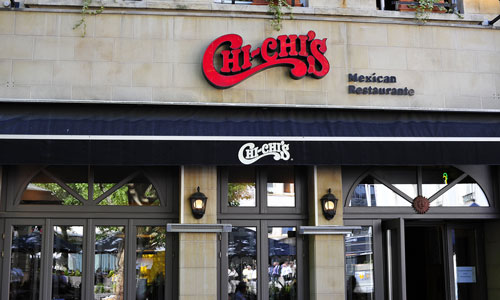
A Chi-Chi's restaurant in Luxembourg. Really. (Jeff Boyd/Flickr)
Five ways departed U.S. food chains have managed to quietly stick around in some form
- The burger chain Wimpy, which was big in the U.S. before World War II, effectively died with its owner, Edward Gold, after ownership of the brand name failed to change hands in the U.S. Outside of the U.S., it was a different story entirely. Having sold the international naming rights to J. Lyons and Co in 1954, the company was a major hit in the U.K. (though is in decline), and remains particularly prominent in South Africa.
- The fate of the Mexican restaurant chain Chi-Chi’s must give the folks at Chipotle some pause. The popular restaurant chain shut down in 2004 after a hepatitis A outbreak at a Pennsylvania restaurant—which came after the company had already filed for bankruptcy—damaged the brand so severely that Outback Steakhouse bought the chain essentially for its real estate. The company lives on, as a grocery salsa brand, as well as in a number of international locations, particularly in Belgium and Luxembourg.
- Red Barn, a chain of farm-themed burger joints popular in the 1960s and 1970s, shut down in the ‘80s with nary a peep. But the idea (and building) lives on in at least one town: Racine, Wisconsin, where a still-operational restaurant called The Farm carries the torch.
- In 2014, the cupcake chain Crumbs infamously (and dramatically) closed its doors, only to reopen some locations a few months later. This past January, however, it happened again—and this time, the brand only lives on as an internet-based outlet, delivering cupcakes nationwide.
- Gino’s, the burger joint founded by still-with-us Baltimore Colts legend Gino Marchetti (who retired from the NFL 50 years ago), shut down in 1982 after a sale to Marriott. But in recent years, the popular chain, which once sported hundreds of locations, has recently seen something of a revival—a “direct descendant,” launched in 2010 by some of the same principals, uses the same logo and rough concept, but with a slight business-model update.
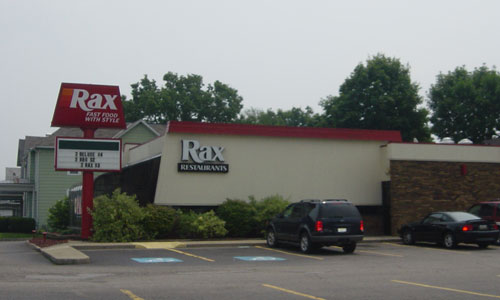
Fast food, with style. (Wikimedia Commons)
The Story of Rax, the fast-food chain that tried to do way too much
All the possible pitfalls that come with trying to launch a national fast food chain can best be highlighted by the fate of Rax Roast Beef.
Coming out of Springfield, Ohio, It was one of many fast food chains to come out of Ohio in the 1960s. Launched in 1967, roughly the same time as Wendy’s in nearby Columbus, and Arby’s on the other side of the state, Rax was once a major fast food chain, with more than 500 locations to its name at its peak.
It also had a complicated corporate history. For one thing, Rax originally wasn’t called Rax, it was called JAX. The founder, Jack Roschman, launched the chain after Ray Kroc declined to let him exclusively operate McDonald’s in Ohio due to his young age. Roschman ended up helping Burger Chef, a similar chain to McDonald’s, get off the ground in Ohio.
(Despite the slight, Kroc nonetheless spoke highly of Roschman, once calling him “the best fast food man in the world,” according to Roschman’s 2009 Palm Beach Post obituary.)
Roschman, who created Jax from whole cloth, quickly sold the brand to General Foods in 1969. During this time, the brand was called RIX Roast Beef. (Roschman also helped co-found another well-known chain of the era, the buffet-driven Ponderosa Steakhouse.)
General Foods proved to be a poor corporate parent, and in 1978, the chain—which had hit an early peak of 195 stores in 1977—fell into disarray, with all but 10 stores closing. A franchisee, Restaurant Administration Corporation, classed up the joint a little bit and changed the name of the chain to Rax Roast Beef. Then, changing their name, they went national.
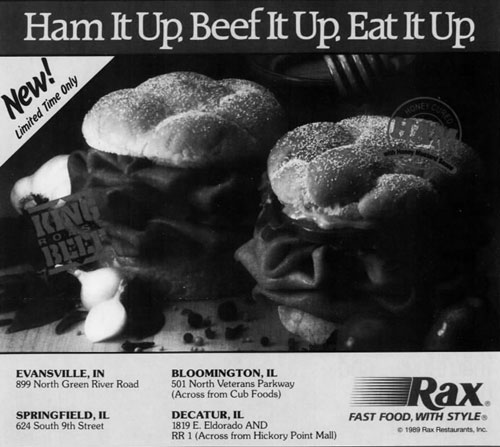
A Rax newspaper ad, circa 1989. (via the Decatur, Illinois Herald and Review)
Soon, the chain ballooned to more than 500 locations—far below Arby’s 2,100 locations in 1989, but a fairly decent-sized business. (Side note: Arby’s also had a fairly tumultuous corporate evolution, quickly falling into bankruptcy, then though a series of corporate takeovers. It must be a sign that selling roast beef is fraught with drama.)
Rax was fairly innovative during this era. According to the book Lost Restaurants of Columbus, Ohio, Rax was the first chain in the country to fry its french fries in vegetable oil, rather than using animal fat. However, Rax made a fairly large strategic mistake. Like Wendy’s, it got caught up in the salad bar trend. Unlike Wendy’s, it strayed far from its roots of selling sandwiches. It quickly became far more known for its unusual menu additions than its roast beef sandwiches.
A 1985 ad, featuring late Garfield voice actor Lorenzo Music, really nails down the problem: The company’s menu was all over the place, promoting chicken, shrimp, and taco salad, all in the span of a single commercial. The chain’s move away from simply selling roast beef eventually turned the restaurant from a contender into a story of failure. It filed for Chapter 11 in 1991, and mostly closed for business by the early ‘90s. Emphasis on mostly.
That’s because, surprisingly, some Rax restaurants are still around—with menus focused on roast beef. The corporate parent is run under a new name, From Rax to Rich’s, reflecting the current owner of the chain, onetime franchise employee Rich Donohue.
“I think it’s a great concept,” Donohue told the Columbus Business Journal in 2009. “I think it’s been beaten down a little, but it still has a pulse. I think I can revive it. It’s not going to happen overnight, but my goal is to regrow the company.”
Rax isn’t the chain it once was, but it still lingers somewhat, a reflection of a time when it coulda been a contender. There was a time when it could’ve been the best lunch option on the strip.
Executives at modern-day restaurant chains probably study the story of Rax very closely—because they know if they don’t play their cards right, this could be their story.
Don’t let this article fool you. Fast food chains are a weird beast—and not every chain goes massive. In reality, restaurants come and go, and often, they barely have a chance to leave their mark.
This month, the Chipotle-owned Asian chain Shophouse, which poured heaping helpings of peanut sauce and Sriracha onto many an office-slave’s crappy week in DC and NYC, closed its doors essentially because Chipotle couldn’t figure out a way to take the chain national and make it as big as Chipotle.
(On the plus side, the chain is being replaced by another Asian chain with a very similar concept.)
Beyond the restaurants themselves, it’s worth keeping in mind that franchising is hard. Really hard. You have to put up a crapload of money right off the bat, too. You have to pay Subway $15,000 just for the right to run a franchise, and it costs at least $116,000 just to get the store open in the first place.
It’s even more for a Nathan’s, too. At the low end, you’d likely pay nearly $300,000 just to put a co-branded Nathan’s and Arthur Treacher’s in a food court, according to Franchise Direct. But on the other hand, if it’s successful, it could be huge. People need to eat, and they’re gonna go with a brand name they recognize if they’re stuck in an airport.
The upside of creating a massively popular fast-food restaurant is huge. A popular chain? Even bigger. If you pull off even 5 percent of McDonald’s global revenue—$6 billion last year, by the way—that’s still a massive business, even if you fail in the U.S. and are stuck trying to rebuild the chain in secondary markets.
No wonder why Kenny Rogers wanted in.
:format(jpeg)/2017/03/tedium032817.gif)
/2017/03/tedium032817.gif)

/uploads/ernie_crop.jpg)